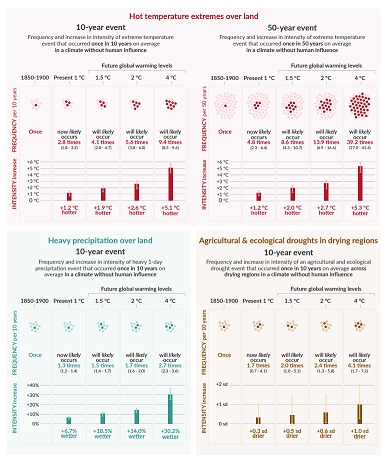Code Red: What does the IPCC Report mean for Liverpool City Region?
Posted on: 13 August 2021 by James Hickson and Sawyer Phinney in Blog

In this blog, Heseltine Institute Research Associates James Hickson and Sawyer Phinney, reflect on the latest Intergovernmental Panel on Climate Change Report and the possible implications for Liverpool City Region’s climate future.
“A code red for humanity”
Climate change is now widespread, rapid, and intensifying. This is the stark message outlined in the latest Intergovernmental Panel on Climate Change (IPCC) Report published this week, with the UN Secretary-General, António Guterres, describing the findings as nothing less than "a code red for humanity".
Published amidst a record breaking summer of extreme weather and natural disasters across the Northern Hemisphere, the report outlines the scale of humanity’s impact on our planet. In 2019, the concentrations of carbon dioxide recorded in our atmosphere were the highest in the last 2 million years. The global surface temperature has warmed since 1970 a rate that is unprecedented in at least the last 2,000 years. Meanwhile, global mean sea level has risen faster since 1900 than over any preceding century in at least the last 3,000 years as a result of rapidly warming oceans and the loss of snow and ice cover on land.
This human-made climate change is already leading to more extreme weather in every region across the globe, with the frequency and intensity of heatwaves, heavy rainfall, droughts, and tropical cyclones having increased significantly since the 1950s. Such weather events will only become more common, and more disastrous, as the planet continues to warm further.
Figure 1: Projected changes in extremes are larger in frequency and intensity with every additional increment of global warming (Source: IPCC)
The time to act is now. The global temperature is now expected to reach or exceed 1.5°C of heating (relative to 1850-1900 temperature) within the next two decades. Every tonne of CO₂ emissions adds to global warming. Without a rapid reduction in greenhouse gas emissions, reaching at least net zero carbon in the coming decades, the report warns that global warming of 2°C (the upper limit set by the Paris Climate Agreement) will be exceeded during the 21st century. If emissions remain high, global temperatures could increase by more than 5°C by 2100. The last time global surface temperature was sustained at or above 2.5°C higher than the 1850–1900 level was over 3 million years ago.
In other words, the Climate Emergency is already here. And, unless we decarbonise our social and economic systems at speed and at scale in the coming years, the environmental conditions that have nurtured human civilisation over millennia could be gone in just a few short decades. The consequences for ecosystems, economies, and communities across the globe will be significant. They could be dire, with the world’s poorest and most disadvantaged populations disproportionately vulnerable to the impacts of climate change.
Liverpool City Region’s climate future?
Along with the rest of Europe, Liverpool City Region can expect average temperatures to rise more rapidly than the global mean. This will increase the intensity and frequency of extreme hot weather events across the continent, and areas in Northern Europe in particular can expect increased flooding from heavy rainfall, as well as more severe wind storms.
The effects of global warming are likely to be magnified in urban areas such as Liverpool City Region. Intensified by the urban heat island effect, cities and their populations will suffer from more severe heat stresses during periods of extreme hot weather. The impact of urbanisation on the water cycle, generating increased precipitation in and around cities, and preventing natural water drainage, also means cities more vulnerable to the threat of flooding as heavy rainfall events become more common as a result of climate change.
Coastal cities, such as Liverpool City Region, face the additional threat of sea level rises, and increased flooding from storm surges. The IPCC report notes that some degree of continuing sea level rise - as a result of historical warming and ice melting - is now almost certainly unavoidable. Moreover, it will take several centuries, if not millennia, for global mean sea level to reverse course even if global warming can be halted now.
Climate change is a global challenge, but it will have severe local consequences for Liverpool City Region. More intense and frequent extreme weather events threaten the lives and livelihoods of residents. Rising sea levels and floods threaten our homes and businesses. And, together, these climate shocks threaten our shared economic prosperity. Unless global warming is urgently addressed, local communities, businesses, supply chains and infrastructures risk repeated disruption from extreme weather, natural disaster, and ecological breakdown, both at home and abroad.
System change, not climate change – at a local level
There is an alternative to this bleak future. But only a concerted and rapid transformation of global social and economic systems – the ways we live, work, and get around – is now sufficient to avert climate disaster. The scale and complexity of this challenge can seem overwhelming, and disempowering. But any global transformation necessarily requires local action.
Liverpool City Region, as a birthplace of the Industrial Revolution and with communities now on the frontline against climate change, has a particular responsibility to show leadership in the face of the Climate Emergency, translating visions for global system change into innovative practical (and exportable) models of urban design, functionality, governance, and prosperity that promote rapid decarbonisation and climate justice in local communities.
Liverpool City Region Combined Authority has already committed to achieving net zero carbon in LCR by 2040, and earlier this year published its Year One Climate Action Plan identifying the immediate steps that can be taken towards realising this goal. In the light of the latest IPCC report, accelerating these immediate actions across the whole City Region is now even more important. Indeed, over the coming years, addressing the Climate Emergency in Liverpool City Region will require:
1. Adaptation
How Liverpool City Region looks, feels, and functions must change markedly as we move towards 2040. This will require adaptation of our built environment and urban infrastructures to ensure that these support and conform with local zero carbon targets. With a high concentration of ageing, poor quality, and energy inefficient housing stock (nearly two thirds of homes in the City Region have an EPC rating of D or less) the decarbonisation of LCR’s homes, through retrofit and redevelopment, will be particularly critical. And supporting residents to switch to sustainable public transport and active travel options will also be needed to break the City Region’s current overdependency on carbon intensive car travel.
Alongside decarbonisation, the City Region will need to strengthen its resilience to inevitable local climate risks, including sea level rises, heatwaves, and floods, as well as the threats these pose to the supply of food, goods and vital services. So far, as the UK’s Climate Change Committee (CCC) noted in June of this year, across the country “adaptation action has failed to keep pace with the worsening reality of climate risk”. It is therefore vital that communities, businesses, and infrastructures across LCR are now adapted as far and as quickly as possible to withstand the stress of the more extreme weather events that we can expect to see in future. Alongside walls, barriers, and other man-made adaptations, nature-based climate solutions will be increasingly valuable. With a similar climate to Liverpool City Region, Copenhagen is responding to the threat of more extreme rainfall through an integrated system of green streets and pocket parks will function as retention areas and water basins. Not only will this green infrastructure help with effective water drainage, but it will also aid urban cooling and reduce CO2 emissions.
However, local funding to support decarbonisation and other climate adaptation policies in UK cities remains scarce. A recent survey suggests that, whilst most local governments in the UK have already declared a climate emergency and are taking action within their budgetary limits, they need more long-term term centralized funding to plan for the future. Such arrangements could include green bonds, a new initiative already utilised by national governments such as Canada (and announced recently by the UK government as part of its Green Financing Framework), to leverage additional private investment to finance energy efficiency programs and renewable energy development. Other schemes could include Pay as You Save (PAYS) programmes that could be used to finance smaller retrofits in housing stocks that run through financial institutions and utility companies, with the loan repaid as a surcharge on household utility bills.
2. Coordination
The time for tokenistic and piecemeal action is over. Only coordinated and sustained action to address the Climate Emergency at the system-level – rapidly decarbonising the totality of urban life in Liverpool City Region in an integrated and synchronised fashion - will be sufficient. To achieve this communities, businesses, and anchor institutions across the City Region should now work together to align their approaches towards investment, planning, and development to ensure these proactively support shared climate targets. Liverpool City Region Combined Authority and the Metro Mayor represent the most obvious focal point for this coordination, reflecting the model of COP26 at the local level to regularly convene key stakeholders in order to deliver coordinated decarbonisation at speed and scale through effective partnerships and joined-up policymaking across the City Region.
Similarly, Liverpool City Region Combined Authority should work with other mayoral combined authorities and local governments across the country to help collectively set the UK’s climate agenda and raise the ambitions of national government. As the CCC has noted, whilst there has been a recent increase in the scale of Government efforts to cut carbon, progress still remains out of step with the urgency of the challenge.
3. A just transition
Whilst the need for decarbonisation is urgent, this transition cannot simply be done to the public by well-meaning policymakers. Instead, the transition to Net Zero must be designed, developed, and delivered with and by communities themselves. Citizens Assemblies, such as those held in Camden, Oxford, and North of Tyne, are one mechanism through which local people can actively shape the transition to Net Zero in their communities and ensure this is delivered in a way that is fair, affordable, and effective.
It is vital, too, that the transition to zero carbon pays the highest dividends to the most disadvantaged. This means realising fully the gains for improved health, wellbeing, and quality of life that more sustainable transportation, higher quality housing, and enhanced natural capital can offer in deprived communities. It also means supporting all people to access the skills, technologies, and opportunities that will enable them to thrive in green jobs. Studies have proven that investments towards a greener economy can be a driver for job creation. Renewable energy, energy efficiency/green buildings, and public transportation, are labour intensive sectors that could significantly increase employment, boost local economies, and contribute to the tax base of the Liverpool City Region.
With the real potential for a Green Industrial Revolution in Liverpool City Region in coming years, linked to key projects such as Mersey Tidal Power, it is vital that these stable, high quality, green jobs are made accessible to all. In this way, the transition to Net Zero can be leveraged not only to rebuild the health of our natural environment, but also to rebuild the wealth of local communities.
Keywords: climate change, net zero.
